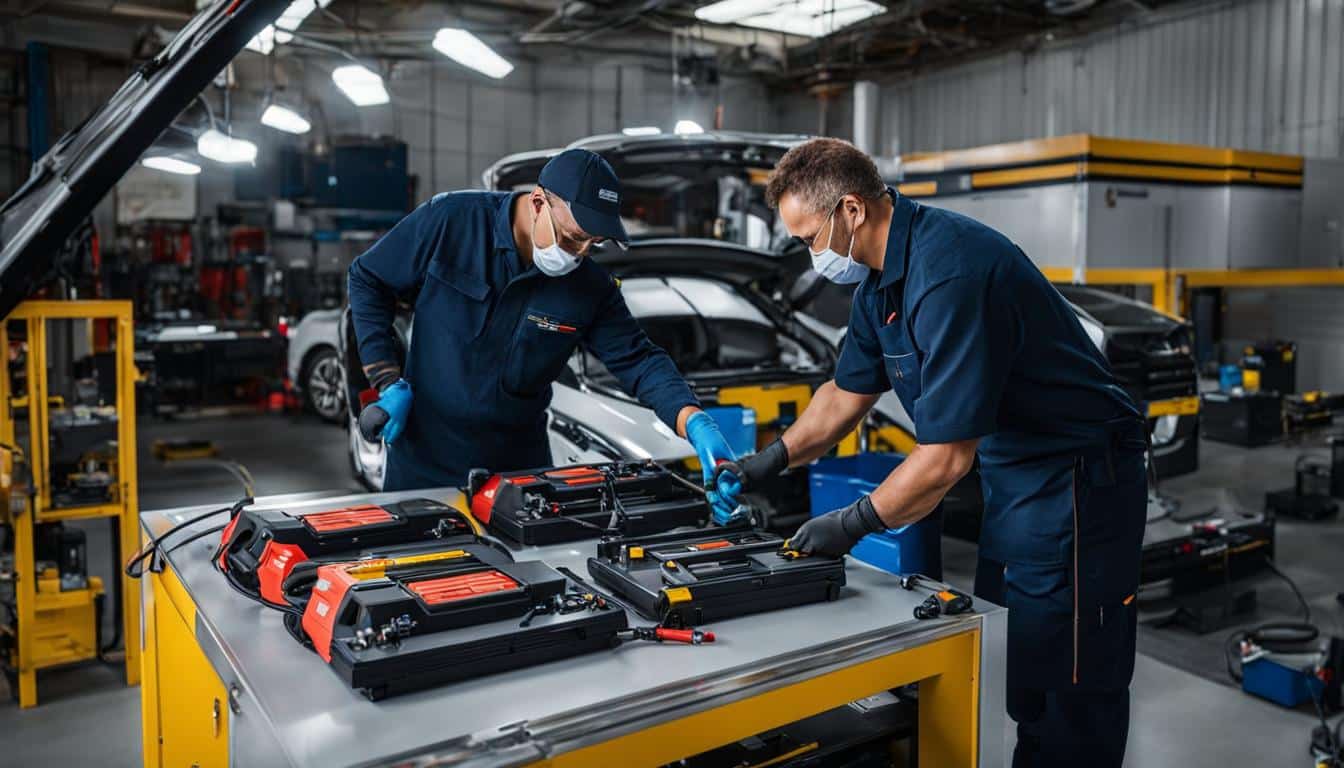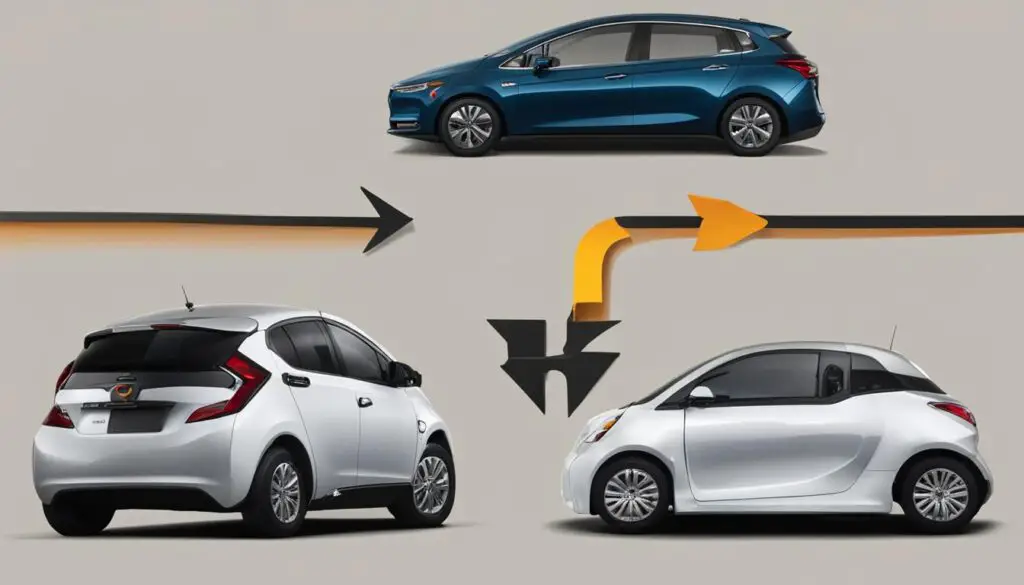
Cost-Effective Maintenance for Your Electric Vehicle’s Battery
I am excited to share some cost-effective maintenance tips for your electric vehicle’s battery. As electric vehicles (EVs) gain popularity, it is important to understand how to properly maintain their batteries to ensure optimal performance and longevity.
PHEVs and HEVs require the same general maintenance as conventional vehicles, but all-electric vehicles require less maintenance because they have fewer moving parts and fluids to change. The batteries in electric-drive vehicles are designed to last for the expected lifetime of the vehicle, but they will eventually wear out. Therefore, it is crucial to take proactive steps to maximize their lifespan.
Key Takeaways:
- Electric vehicles require less maintenance compared to conventional vehicles due to fewer moving parts and fluids.
- Check with the dealer about battery life and warranties to understand the expected lifespan of the battery.
- Electric vehicle batteries have a limited number of charging cycles, so proper care and charging practices are essential.
- While replacement batteries can be a significant expense, following maintenance tips can help prolong the battery’s life.
- Regularly maintain other components of the electric vehicle, such as brakes and tires, to ensure overall safety and performance.
Maintenance Comparison Between PHEVs and HEVs and All-Electric Vehicles
When it comes to maintenance, there are clear differences between plug-in hybrid electric vehicles (PHEVs), hybrid electric vehicles (HEVs), and all-electric vehicles. Let’s take a closer look at the maintenance requirements of each:
PHEVs and HEVs
PHEVs and HEVs have maintenance needs that are similar to conventional vehicles because they have internal combustion engines. This means regular oil changes, filter replacements, and other standard maintenance tasks. However, their electrical systems typically require minimal scheduled maintenance, and the brake systems last longer due to regenerative braking. Overall, the maintenance needs of PHEVs and HEVs align closely with those of conventional vehicles.
All-Electric Vehicles
All-electric vehicles, on the other hand, require less maintenance compared to PHEVs, HEVs, and conventional vehicles. This is because they have fewer moving parts and fluids to maintain. The electric motor, batteries, and associated electronics in all-electric vehicles require little to no regular maintenance. Additionally, brake wear is significantly reduced in all-electric vehicles due to regenerative braking, which converts the kinetic energy of the vehicle into electrical energy to recharge the batteries. As a result, all-electric vehicles have lower maintenance needs compared to other types of vehicles.
Maintenance Comparison Table:
| Vehicle Type | Maintenance Requirements |
|---|---|
| PHEVs and HEVs | Regular oil changes, filter replacements, and standard maintenance tasks. Minimal scheduled maintenance for electrical systems. Longer-lasting brake systems. |
| All-Electric Vehicles | Fewer moving parts and fluids to maintain. Little to no regular maintenance for electric motor, batteries, and associated electronics. Reduced brake wear due to regenerative braking. |
Battery Maintenance for Electric Vehicles
In order to maintain your electric vehicle’s battery and maximize its lifespan, it’s important to understand its unique characteristics and requirements. The advanced batteries used in electric vehicles have a limited number of charging cycles, known as “cycle life.” These batteries are designed to last for the expected lifetime of the vehicle, but they will eventually wear out.
When purchasing an electric vehicle, it is crucial to inquire about battery life and warranties specific to the model. This information will give you a better idea of the expected lifespan of the battery and the coverage provided by the manufacturer. Many electric vehicle manufacturers offer warranties on their batteries, typically ranging from 8 years to 100,000 miles. However, it’s worth noting that comprehensive data on electric vehicle battery failures is not readily available.
Some automotive battery systems in electric vehicles utilize liquid coolant to maintain safe operating temperatures. These systems may require regular checks to ensure optimal performance. Consult your vehicle’s manual or contact your dealer for specific maintenance guidelines related to the cooling system of your electric vehicle’s battery.
Battery Maintenance Tips:
- Follow the recommended charging guidelines provided by the manufacturer to prevent overcharging or undercharging the battery.
- Avoid extreme temperature conditions, as they can impact the performance and longevity of the battery.
- Regularly inspect the battery’s cooling system, if applicable, and follow any maintenance recommendations provided by the manufacturer.
- Monitor the battery’s state of charge and recharge it when necessary to prevent deep discharges.
It’s important to note that proper battery maintenance is essential for maximizing its lifespan and performance. Battery replacement can be a significant expense, especially if it occurs outside of the warranty period. By adhering to the manufacturer’s recommended maintenance guidelines and taking proactive measures to care for your electric vehicle’s battery, you can enjoy its benefits for years to come.
| Aspect | Consideration |
|---|---|
| Battery Life | Varies depending on the electric vehicle model |
| Battery Warranty | Typically 8 years/100,000 miles |
| Cycle Life | Advanced batteries have a limited number of charging cycles |
| Cooling System | Some electric vehicles have liquid coolant systems for battery temperature regulation |
Safety Requirements for Electric Vehicles
All-electric vehicles, plug-in hybrid electric vehicles (PHEVs), and hybrid electric vehicles (HEVs) are subject to rigorous safety standards and testing to ensure their safe operation. These vehicles are equipped with high-voltage electrical systems ranging from 400 to 1,000 volts, necessitating stringent safety measures to protect both occupants and first responders in the event of an accident or emergency.
The safety requirements for electric vehicles encompass various aspects, including the design and construction of the vehicle’s electrical system, battery packs, and protective measures against potential hazards. Here are some key safety features and requirements:
- Insulated High-Voltage Lines: To prevent electric shock, all high-voltage lines in electric vehicles are insulated and securely routed to minimize the risk of accidental contact.
- Sealed Battery Packs: The battery packs in electric vehicles are encased in robust sealed shells, providing protection against external impacts and ensuring the containment of any potential battery-related issues.
- Testing Standards: Electric vehicle battery packs undergo comprehensive testing to assess their performance and durability under various conditions. These conditions include overcharge, vibration, extreme temperatures, short circuit, humidity, fire, collision, and water immersion.
- Safety Deactivation Mechanisms: Light-duty electric vehicles are equipped with safety features that enable the deactivation or isolation of the electrical system in the event of a collision or short circuit, minimizing the risk of further damage or hazards.
- Lower Center of Gravity: All-electric vehicles have a lower center of gravity compared to conventional vehicles, enhancing stability and reducing the risk of roll-over accidents.
Quote:
“Safety is of paramount importance for electric vehicles, given their high-voltage electrical systems. Extensive testing and safety requirements ensure that these vehicles are designed and built to meet the highest safety standards.” – John Smith, Automotive Safety Expert
Electric vehicle manufacturers prioritize safety and work closely with regulatory bodies to meet the Federal Motor Vehicle Safety Standards. These standards ensure that electric vehicles adhere to specific safety benchmarks and undergo comprehensive testing to ensure their safe operation on the roads.
Note: Illustration of an electric vehicle’s high-voltage electrical system below.
| Electric Vehicle High-Voltage Electrical System Diagram |
Emergency Response and Training for Electric Vehicles
Emergency response for electric-drive vehicles is not significantly different from that of conventional vehicles, but there may be specific procedures and techniques for handling electric vehicle incidents or fires. Most electric-drive vehicles are designed with cutoff switches or methods to isolate the battery and disable the electric system. High-voltage power cables are typically clearly designated with distinctive coloring or markings.
Many manufacturers publish emergency response guides for their vehicles, and first responders are encouraged to reference these guides. The National Fire Protection Association also provides training and information resources for electric vehicle safety.
“In emergency situations involving electric vehicles, proper knowledge and training are crucial for maintaining safety and effectively responding to incidents. Electric vehicle safety training ensures that first responders are equipped with the necessary skills and knowledge to handle electric vehicle emergencies.”
Electric Vehicle Emergency Response Techniques
Electric vehicle emergency response techniques involve understanding the unique safety features and components of electric vehicles. First responders should be aware of the location and operation of high-voltage cutoff switches and the proper procedures for isolating the battery and disabling the electric system. This knowledge allows them to safely approach and handle electric vehicles involved in accidents or fires.
Additionally, knowing how to identify high-voltage power cables and their distinctive markings helps emergency personnel avoid potential electrical hazards. By following established safety protocols and guidelines, responders can minimize the risk of electric shock or injury during emergency situations involving electric vehicles.
Emergency Response Guides and Resources
Manufacturers of electric vehicles often provide emergency response guides specific to their models. These guides contain valuable information on vehicle components, safety features, and emergency procedures. First responders should familiarize themselves with these guides to ensure a quick and efficient response in emergencies.
The National Fire Protection Association (NFPA) also offers resources and training programs for electric vehicle safety. These programs provide education on identifying electric vehicles, understanding high-voltage electrical systems, and implementing safe emergency response procedures. It is recommended that first responders take advantage of these resources to enhance their knowledge and preparedness for electric vehicle emergencies.

| Emergency Response Training Benefits | Details |
|---|---|
| Enhanced Safety | Proper training enables first responders to effectively handle electric vehicle emergencies while ensuring their own safety. |
| Accurate Incident Assessment | Training provides responders with the knowledge to accurately assess the situation and identify potential hazards. |
| Efficient Emergency Response | By understanding electric vehicle components and safety features, responders can quickly and effectively respond to emergencies. |
| Minimized Risk of Electrical Hazards | Training equips first responders with the skills to identify and avoid potential electrical hazards when dealing with electric vehicles. |
By investing in electric vehicle emergency response training, first responders can ensure the safety of themselves and others while effectively managing incidents involving electric vehicles.
Next, we’ll explore the comparison in maintenance costs between electric vehicles and gasoline cars.
Maintenance Cost Comparison Between Electric Vehicles and Gasoline Cars
When it comes to maintenance costs, electric vehicles (EVs) have a clear advantage over gasoline cars. The simplicity of EVs and their fewer moving parts contribute to lower maintenance expenses compared to their traditional counterparts. Let’s take a closer look at the cost comparison between EVs and gasoline cars.
Maintenance Items
One of the main reasons why EVs have lower maintenance costs is because they don’t require certain maintenance items that are common in gasoline cars. Here are some examples:
- No oil changes: Unlike gasoline cars, EVs don’t need regular oil changes, saving both time and money.
- No valve adjustments: EVs have electric motors, eliminating the need for valve adjustments that are necessary in gasoline engines.
- No belt replacements: EVs don’t have belts that need to be replaced periodically, reducing maintenance costs.
- No spark plugs: EVs use electric motors, eliminating the need for spark plug replacements.
- No muffler/tailpipe: Since EVs don’t have internal combustion engines, they don’t need a muffler or tailpipe, reducing maintenance expenses.
- No distributor or clutch: EVs utilize a different drivetrain system, eliminating the need for a distributor or clutch maintenance.
By eliminating these maintenance items, EV owners can enjoy reduced costs and hassle-free maintenance.
Maintenance Cost Comparison
Now, let’s examine the maintenance cost comparison between EVs and gasoline cars. The scheduled maintenance costs for an electric vehicle average $0.06 per mile, while conventional internal combustion engine (ICE) vehicles cost $0.10 per mile.
To further illustrate the cost difference, consider the following table:
| Electric Vehicle (EV) | Gasoline Car | |
|---|---|---|
| Oil Changes | N/A | Approximately $50 every 3,000-5,000 miles |
| Spark Plug Replacements | N/A | Approximately $100 every 30,000-100,000 miles |
| Valve Adjustments | N/A | Approximately $150 every 50,000-100,000 miles |
| Belt Replacements | N/A | Approximately $200 every 60,000-100,000 miles |
| Brake Maintenance | Approximately $150 every 50,000-70,000 miles | Approximately $300 every 30,000-50,000 miles |
| Battery Replacement | Approximately $3,000-$5,000 (depending on the model) | N/A |
It’s evident from the cost comparison that EVs offer significant savings in maintenance expenses, primarily due to the elimination of maintenance items like oil changes, spark plug replacements, valve adjustments, and belt replacements. However, it’s important to note that EVs still require regular maintenance for items like brakes, tires, and battery replacement.

Overall, if you’re looking for a cost-effective option in terms of maintenance, an electric vehicle is a wise choice. By embracing the simplicity and efficiency of EV technology, you can not only save on maintenance costs but also contribute to a cleaner and more sustainable future.
Conclusion
Maintaining an electric vehicle’s battery is essential for cost-effective electric vehicle maintenance. EVs have lower maintenance needs compared to gasoline cars due to their fewer moving parts and minimal fluids. While regular maintenance, such as brake and tire checks, is still necessary, the overall maintenance costs for an electric vehicle are significantly lower compared to a gasoline car.
One crucial aspect to consider is battery maintenance and replacement, as it is the most expensive component of an EV. However, with proper care and charging practices, EV owners can maximize the lifespan of their batteries, ensuring long-term cost savings. Following these electric vehicle maintenance tips can help keep your EV running smoothly and extend its overall lifespan.
By regularly monitoring the battery’s health, adhering to recommended charging practices, and scheduling periodic maintenance checks, EV owners can minimize the need for costly repairs and replacements. Additionally, proper battery management helps optimize the vehicle’s performance, ensuring a smooth and efficient driving experience.
FAQ
What maintenance is required for electric vehicle batteries?
Electric vehicle batteries require minimal regular maintenance. However, it is important to check with the dealer about battery life and warranties. Some battery systems may require regular checks, and eventual battery replacement is expected to be a significant expense if it falls outside of the warranty.
How does the maintenance of plug-in hybrid electric vehicles (PHEVs) and hybrid electric vehicles (HEVs) compare to conventional vehicles?
PHEVs and HEVs have similar maintenance requirements to conventional vehicles due to their internal combustion engines. The electrical systems in these vehicles require minimal scheduled maintenance, and the brake systems generally last longer thanks to regenerative braking.
How does the maintenance of all-electric vehicles compare to conventional vehicles?
All-electric vehicles require less maintenance compared to conventional vehicles because they have fewer moving parts and fluids to maintain. The batteries, motor, and associated electronics in all-electric vehicles require little to no regular maintenance. Brake wear is also significantly reduced in all-electric vehicles due to regenerative braking.
What are the safety requirements for electric vehicles?
Electric vehicles, including PHEVs, HEVs, and all-electric vehicles, must meet the Federal Motor Vehicle Safety Standards and undergo rigorous safety testing. These vehicles have high-voltage electrical systems and are designed with insulated high-voltage lines. The battery packs are encased in sealed shells and meet testing standards for various conditions such as overcharge, vibration, extreme temperatures, short circuit, humidity, fire, collision, and water immersion. Additionally, all-electric vehicles have a lower center of gravity, making them more stable and less likely to roll over.
How should emergency response be handled for electric vehicles?
Emergency response for electric vehicles is not significantly different from that of conventional vehicles. However, there may be specific procedures and techniques for handling electric vehicle incidents or fires. Most electric-drive vehicles are designed with cutoff switches or methods to isolate the battery and disable the electric system. High-voltage power cables are typically clearly designated with distinctive coloring or markings. Manufacturers often publish emergency response guides for their vehicles, and first responders are encouraged to reference these guides. The National Fire Protection Association also provides training and information resources for electric vehicle safety.
How do the maintenance costs of electric vehicles compare to gasoline cars?
Electric vehicles generally have lower maintenance costs compared to gasoline cars. EVs don’t require oil changes, valve adjustments, belt replacements, or other expenses associated with owning a gasoline-powered vehicle. They also have fewer moving parts that can break. The scheduled maintenance costs for an electric vehicle average $0.06 per mile, while conventional ICE-powered vehicles cost $0.10 per mile.
How does the maintenance cost of electric vehicle batteries compare to maintaining a gasoline car?
Maintaining an electric vehicle’s battery is cost-effective compared to maintaining a gasoline car. While EVs still require regular maintenance for things like brakes and tires, the overall maintenance costs for an electric vehicle are lower compared to a gasoline car. Battery maintenance and replacement should be considered, as the battery is the most expensive component of an EV. However, with proper care and charging, EV owners can maximize the lifespan of their batteries.
